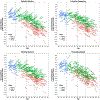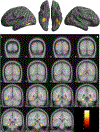Functional activation features of memory in successful agers across the adult lifespan
- PMID: 35523368
- PMCID: PMC9364925
- DOI: 10.1016/j.neuroimage.2022.119276
Functional activation features of memory in successful agers across the adult lifespan
Abstract
Much neuroimaging research has explored the neural mechanisms underlying successful cognitive aging. Two different patterns of functional activation, maintenance of youth-like activity and compensatory novel recruitment, have been proposed to represent different brain functional features underlying individual differences in cognitive aging. In this study, we investigated the functional features in individuals across the adult lifespan who appeared to resist age-related cognitive decline, in comparison to those with typical age-related declines, over the course of four years. We first implemented latent mixture modeling, a data-driven approach, to classify participants as successful and average agers in middle-aged, young-old, and very old groups, based on their baseline and longitudinal cognitive performance. Then, using fMRI with a subsequent memory paradigm at the follow-up visit, brain activation specifically related to successful encoding (i.e., subsequent memory effect: subsequently remembered with high confidence > subsequently forgotten) was compared between people who established successful cognitive aging versus average aging in the three age groups. Several differences in the subsequent memory effect were revealed. First, across core task-related regions commonly used during successful encoding, successful agers exhibited high subsequent memory effect, at a level comparable to the young control group, until very old age; in contrast, average agers showed reduced subsequent memory effect, compared to successful agers, beginning in young-old age when memory performance also reduced in average agers, compared to successful agers. Second, additional recruitment in prefrontal clusters, distant from the core task-related regions, were identified in the left superior frontal and right orbitofrontal cortices in successful agers of young-old age, possibly reflecting functional compensation in successful aging. In summary, successful agers demonstrate a pattern of youth-like activation spanning from middle age to young-old age, as well as novel frontal recruitment in young-old age. Overall, our study demonstrated evidence of two neural patterns related to successful cognitive aging, offering an integrated view of functional features underlying successful aging, and suggests the importance of studying individuals across the lifespan to understand brain changes occurring in mid and early-late life.
Keywords: Brain maintenance; Compensation; Dedifferentiation; Subsequent memory; Successful aging; fMRI.
Copyright © 2022. Published by Elsevier Inc.
Figures










References
-
- Aguirre GK, Detre JA, Alsop DC, D’Esposito M, 1996. The parahippocampus subserves topographical learning in man. Cereb. Cortex 6, 823–829. - PubMed
-
- Ardila A, 2007. Normal aging increases cognitive heterogeneity: analysis of dispersion in WAIS-III scores across age. Arch. Clin. Neuropsychol. 22, 1003–1011. - PubMed
-
- Backman L, Lindenberger U, Li SC, Nyberg L, 2010. Linking cognitive aging to alterations in dopamine neurotransmitter functioning: recent data and future avenues. Neurosci. Biobehav. Rev. 34, 670–677. - PubMed
-
- Badre D, Wagner AD, 2007. Left ventrolateral prefrontal cortex and the cognitive control of memory. Neuropsychologia 45, 2883–2901. - PubMed

